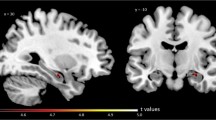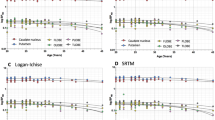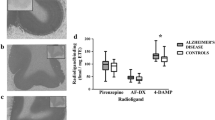Abstract
A loss of acetylcholine is one of the most consistent neurochemical findings in Alzheimer's disease (AD) post-mortem, but the debate concerning receptor abnormalities is unresolved. The aim of this investigation was to measure the density of acetylcholine muscarinic receptors in AD patients at various stages in the disease (N = 8) by synthesising a radio-iodinated version of quinuclidinyl benzilate QNB, a potent muscarinic antagonist. Deficits were identified by comparison with a control data set obtained from four elderly volunteers and then compared to the deficit in total functional activity in the same brain regions measured using the cerebral perfusion tracer technetium-99m hexamethylpropylene amine oxime. Iodine-123 (R, R)quinuclidinyl benzilate (QNB) was synthesised using a CuI assisted nucleophilic aromatic exchange reaction. 160 MBq of the radioligand (specific activity 400 Ci/mmol: dose 90 ng/kg) was administered to each subject. Diagnosis of AD was made using the CAMDEX and DSMIIIR criteria with a physical examination, full blood screen, CT and chest X-ray. All subjects were scanned at 21 h post injection on an SME810 emission tomograph. 123I(R, R)QNB activity in the controls was found to be consistent with the known distribution of muscarinic receptors with no activity in the cerebellum and low activity in the thalamus. In the AD patients deficits in 123I-QNB binding which exceeded the corresponding total functional regional perfusion deficit were not found in six of the patiens and were observed only in the two most severely affected patients, both of whom were untestable on the cognitive battery. This adds weight to the evidence that a major reduction in postsynaptic receptor density takes place only at a very late stage of AD.
Similar content being viewed by others

References
Rossor MN, Garrett NJ, Johnson AL, Mountjoy CQ, Roth M, Iversen LL. A post-mortem study of the cholinergic and GABA systems in senile dementia. Brain 1982; 105:313–330.
Bird TD, Stranahan S, Sumi SM, Raskind M. Alzheimer's disease choline acetyltransferase activity in brain tissue from clinical and pathological subgroups. Ann Neurol 1983; 14:284–293.
DeKosky ST, Scheff SW, Markesbery WR. Laminar organization of cholinergic circuits in human frontal cortex in Alzheimer's disease and aging. Neurology 1985; 35:1425–1431.
Sims NR, Bowen DM, Smith CC, Flack RH, Davison AN, Snowden JS, Neary D. Glucose metabolism and acetylcholine synthesis in relation to neuronal activity in Alzheimer's disease. Lancet 1980; I:333–336.
Bowen DM, Allen SJ, Benton JS, Goodhardt MJ, Haan EA, Palmer AM, Sims NR, Smith CC, Spillane JA, Esiri MM, Neary D, Snowdon JS, Wilcock GK, Davison AN. Biochemical assessment of serotonergic and cholinergic dysfunction and cerebral atrophy in Alzheimer's disease. J Neurochem 1983; 41:266–272.
Davies P, Verth AH. Regional distribution of muscarinic acetylcholine receptor in normal and Alzheimer's type dementia brains. Brain Res 1979; 138:385–392.
Caulfield MP, Straughan DW, Cross AJ, Crow T, Birdsall NJM. Cortical muscarinic receptor subtypes and Alzheimer's disease. Lancet 1982; II:1277.
Lang W, Henke H. Cholinergic receptor binding and autoradiography in brains of non-neurological and senile dementia of Alzheimer-type patients. Brain Res 1983; 232:271–280
Kellar KJ, Whitehouse PJ, Martino-Barrows AM, Marcus K, Price DL. Muscarinic and nicotinic cholinergic binding sites in Alzheimer's disease cerebral cortex. Brain Res 1987; 436:62–68.
Waller SB, Ball MJ, Reynolds MA, London ED. Muscarinic binding and choline acetyltransferase is postmortem brain of demented patients. Can J Neurol Sci 1986; 13:528–532.
Nordberg A, Nyberg P, Adolfsson R, Winbald B. Cholinergic, topography in Alzheimer brains: a comparison with changes in the monoaminergic profile. J Neural Transm 1987; 69:19–32.
Rinne JO, Laakso K, Lonnberg P, Molsa P, Paljarvi L, Rinne, JK, Sako E, Rinne UK. Brain muscarinic receptors in senile dementia. Brain Res 1985; 336:19–25.
Shimohama S, Taniguchi T, Fujiwara M, Kameyama M. Changes in nicotinic and muscarinic cholinergic receptors in Alzheimer type dementia. J Neurochem 1986; 46:288–293
Smith CJ, Perry EK, Perry RH, Candy JM, Johnson M, Bonham JR, Dick DJ, Fairbairn A, Blessed G, Birdsall NJ. Muscarinic cholinergic receptor subtypes in hippocampus in human cognitive disorders. J Neurochem 1988; 50:847–856.
Holman BL, Gibson RE, Hill TC, Eckelman WC, Albert M, Reba RC. Muscarinic acetylcholine receptors in Alzheimer's disease. JAMA 1985; 254:3063–3066.
Weinberger DR, Gibson R, Coppola R, Jones DW, Molchan S, Sunderland T, Berman KF, Reba RC. The distribution of cerebral muscarinic receptors in-vivo in patients with dementia. Arch Neurol 1991;48:169–176.
Weinberger DR, Jones D, Reba RC, Mann U, Coppola R, Gibson R, Gorey J, Braun SA, Chase TN. A comparison of FDG PET and IQNB SPELT in normal subjects and in patients with dementia. J Neuropsychiatry Clinical Neurosci 1992; 4:239–248.
Roth M, Tym E, Mountjoy CW, Huppert FA, Hendrie H, Verma S, Goddard R. CAMDEX: a standardised instrument for the diagnosis of mental disorder in the elderly with special reference to the early detection of dementia. Br J Psychiatry 1986;149:698–709
Folstein MF, Folstein SE, McHugh PR. “Mini Mental State”. A practical method for grading the cognitive state of patients for the clinician. J Psychiatr Res 1975; 12:189–198.
American Psychiatric Association. DSMIIIR. Washington, DC: American Psychiatric Association, 1987.
Neirinckx RD, Canning LR, Piper IM, Nowotnik DP, Pickett RD, Holmes RA, Volkert WA, Forster AM, Weisner PS, Marriot JA, Chaplin SB. Technetium 99m d, l-HMPAO: a new radiopharmaceutical for SPECT imaging regional cerebral blood perfusion. J Nucl Med 1987; 28:191–202
Owens J, Murray T, McCulloch J, Wyper D. Synthesis of (R,R) 123I-QNB, a SPECT imaging agent for cerebral muscarinic acetylcholine receptors in vivo. J Labelled Compounds Radiopharmaceuticals 31:45–60.
Gibson RE, Rzeszotarksi WJ, Jagoda EM, Francis BE, Reba RC, Eckelman WC [125I]3-Quinuclidinyl 4-iodobenzilate: a high affinity, high specific activity radioligand for the M1 and M2-acetylcholine receptors. Life Sci 1984; 34:2287–2296.
McCulloch J. Mapping functional alterations in the CNS with [14C]deoxyglucose. In: Iversen LL, Iversen SD, Snyder SH eds. Handbook of psychopharmacology, vol 15. New York: Plenum Press, 1982:321–410.
Dewar D. Neurotransmitter abnormalities associated with the neuropathology of Alzheimer's disease. In: Kerwin R, ed. Neurobiology and psychiatry. Cambridge: Cambridge University Press; 1991: 61–94
Hohmann C, Antuono P, Coyle JT. Basal forebrain cholinergic neurons and Alzehimer's disease. In: Iversen LL, Iversen SD, Snyder SH, eds. Handbook of psychopharmacology, vol 20. New York: Plenum Press; 1988:69–106
Probst A, Cortes R, Ulrich J, Palacios JM. Differential modification of muscarinic cholinergic receptors in the hippocampus of patients with Alzheimer's disease: an autoradiographic study. Brain Res 1988; 450:190–201
Author information
Authors and Affiliations
Additional information
Correspondence to: D.J. Wyper
Rights and permissions
About this article
Cite this article
Wyper, D.J., Brown, D., Patterson, J. et al. Deficits in iodine-labelled 3-quinuclidinyl benzilate binding in relation to cerebral blood flow in patients with Alzheimer's disease. Eur J Nucl Med 20, 379–386 (1993). https://doi.org/10.1007/BF00208995
Received:
Revised:
Issue Date:
DOI: https://doi.org/10.1007/BF00208995



